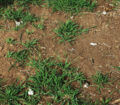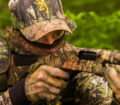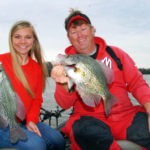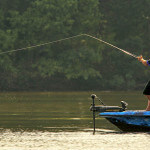Editor’s Note: Since some states’ turkey seasons continue through the first part of May, and others don’t end until May 31st or even in June, we’re looking this week at more ways to take turkeys.
 Calm down, slow down, think before you move, and stop somewhat short of where you think you should set-up are thoughts I tell myself every morning before I go turkey hunting. One of my favorite activities in life is running to a gobbling turkey. I like to get close enough to the bird to take a stand and begin to call to him before he leaves the roost. However, when my feet take wing, my brain tends to disengage. I usually overrun the tom, spooking him off the roost.
Calm down, slow down, think before you move, and stop somewhat short of where you think you should set-up are thoughts I tell myself every morning before I go turkey hunting. One of my favorite activities in life is running to a gobbling turkey. I like to get close enough to the bird to take a stand and begin to call to him before he leaves the roost. However, when my feet take wing, my brain tends to disengage. I usually overrun the tom, spooking him off the roost.
To prevent this from happening, I make a mental decision before I start the race to always stop 30 yards short of where I think I should set-up. I don’t believe I’ve ever failed to bag a turkey by taking a stand too far away from him. Besides, I always can move closer, if I don’t believe the turkey can hear me. But I have spooked many gobblers by trying to get too close before I’ve started to call them.
Sometimes I expect the turkey to read my stopwatch. I know how much time the turkey will require to come from where he is to where I am. If he doesn’t arrive at the appointed time, I get fidgety. If the bird’s 10-15 minutes late, I often assume he isn’t coming at all and will attempt to reposition myself. I’ve spooked many turkeys because of my impatience.
If you watch turkeys walking through the woods, unless they’re really fired-up about mating, they often casually will stroll to you, feeding and listening as they come. Since a turkey’s stride is less than a foot, think about how long the turkey must walk to get from where he is to where you are. Because a man’s stride is approximately 2-1/2- to 3-feet long, and you walk toward a turkey at a steady pace, you may arrive at the spot where the turkey is three times faster than the turkey can walk to you, if he isn’t feeding.
 Therefore, unless you have a sex-crazed gobbler who wants to run in and breed quickly, wait three times longer than you think you should before you leave your stand. When I believe a turkey’s left my area and I think the time has come for me to move, I look at my watch and make myself sit still another 30 minutes. I’ve increased the numbers of turkeys I’ve had the opportunity to take by at least 35 to 40 percent by following this strategy.
Therefore, unless you have a sex-crazed gobbler who wants to run in and breed quickly, wait three times longer than you think you should before you leave your stand. When I believe a turkey’s left my area and I think the time has come for me to move, I look at my watch and make myself sit still another 30 minutes. I’ve increased the numbers of turkeys I’ve had the opportunity to take by at least 35 to 40 percent by following this strategy.
I once was of the old school of call-a-little and wait-a-lot. Well-known turkey hunter, Larry Norton of Butler, Alabama, showed me a more-productive tactic. We had three gobblers talking to us one morning at first light when I hunted Bent Creek Lodge (http://www.bentcreeklodge.com/) in Jachin, Alabama. We re-positioned on the
turkeys two times. Each time Norton continued to call the turkeys, even when they were gobbling. The last stand we took, Norton called to the gobblers and didn’t cease his calling until after the wind had carried the smoke from my gun barrel out of the area, and the bird lay still on the ground.
“I believe more gobblers hang-up and won’t come in because they can’t hear the hen than hang-up from too much calling,” Norton explained. “From watching turkeys, I’ve noticed that as long as the gobbler can hear the hen talking, he’ll walk at a steady pace.”
 I have made most of the mistakes a turkey hunter can make at least four times. However, if you’ll learn from my mistakes, and try some of these common-sense tactics, you’ll bag more longbeards this spring.
I have made most of the mistakes a turkey hunter can make at least four times. However, if you’ll learn from my mistakes, and try some of these common-sense tactics, you’ll bag more longbeards this spring.
To learn more about turkey hunting, check out John E. Phillips’ print, Audible, Kindle and Nook turkey books at https://johninthewild.com/books/#turkey and at www.barnesandnoble.com. You also can download a free Kindle app that enables you to read the book on your iPad, computer or SmartPhone. You can learn more about calling turkeys by going to johninthewild.com/audio-files/ for audio turkey tapes to purchase of Lovett Williams, Rob Keck and Chris Kirby, available for download to your SmartPhone, tablet or computer. For a free copy of John E. Phillips’ “The Turkey Gobbler Getter Manual,” go to https://johninthewild.com/free-books/ to download.
Tomorrow: Follow These Steps to Miss Fewer Turkeys










